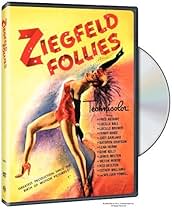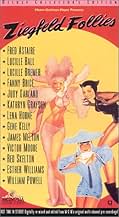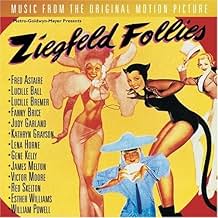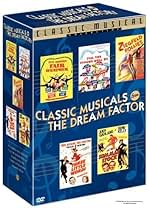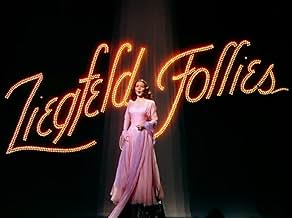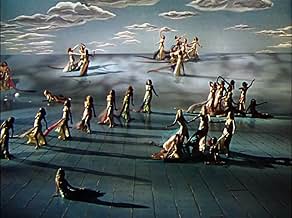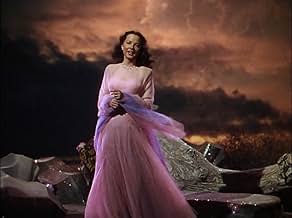AVALIAÇÃO DA IMDb
6,4/10
3,9 mil
SUA AVALIAÇÃO
Adicionar um enredo no seu idiomaThe late, great impresario Florenz Ziegfeld Jr. looks down from Heaven and ordains a new revue in his grand old style.The late, great impresario Florenz Ziegfeld Jr. looks down from Heaven and ordains a new revue in his grand old style.The late, great impresario Florenz Ziegfeld Jr. looks down from Heaven and ordains a new revue in his grand old style.
- Prêmios
- 1 vitória e 1 indicação no total
Avaliações em destaque
This film is just what it says on the tin, a collection of pieces and sketches similar to those you would have seen in a real Ziegfeld show.
Introduced from Heaven by Ziegfeld himself (William Powell reprising his role of ten years earlier), the acts are rolled out one by one for our appreciation and enjoyment.
High points which spring to mind are Fred Astaire as a jewel thief, charming Lucille Bremer; and as a Chinese n'er do well wishing he could get Bremer the fan she wants. Cyd Charisse and others dancing through bubbles as Kathryn Grayson warbles 'Beauty'. Judy Garland as 'the great lady' mocking Greer Garson. And of course 'The Babbitt and the Bromide' which teams Astaire and Gene Kelly for the first time.
The comedy segments sit less well today and all are too long, however, they're not bad. Keenan Wynn struggles with a dumb telephone operator; Victor Moore has a tightwad lawyer who gets him into jail; Fanny Brice wins the Irish sweepstake; and Red Skelton advertises Guzzler's Gin.
Add Lucille Ball and her cat girls, a touch of La Traviata, and a bevy of lovelies to open and close the show, and you can see why this film was a hit on its first release.
Good for historical interest and the frequent highs, but you might find your attention wandering now and then.
Introduced from Heaven by Ziegfeld himself (William Powell reprising his role of ten years earlier), the acts are rolled out one by one for our appreciation and enjoyment.
High points which spring to mind are Fred Astaire as a jewel thief, charming Lucille Bremer; and as a Chinese n'er do well wishing he could get Bremer the fan she wants. Cyd Charisse and others dancing through bubbles as Kathryn Grayson warbles 'Beauty'. Judy Garland as 'the great lady' mocking Greer Garson. And of course 'The Babbitt and the Bromide' which teams Astaire and Gene Kelly for the first time.
The comedy segments sit less well today and all are too long, however, they're not bad. Keenan Wynn struggles with a dumb telephone operator; Victor Moore has a tightwad lawyer who gets him into jail; Fanny Brice wins the Irish sweepstake; and Red Skelton advertises Guzzler's Gin.
Add Lucille Ball and her cat girls, a touch of La Traviata, and a bevy of lovelies to open and close the show, and you can see why this film was a hit on its first release.
Good for historical interest and the frequent highs, but you might find your attention wandering now and then.
No doubt the jaded postmodern cynical viewer will find plenty to pick apart in this fluff (facile metaphysics, etc.). That is their loss.
This is not one of the great MGM musicals, but at its best it does what great musicals do: it sweeps you along in a kaleidoscope of color, movement and sound. And because of these qualities this trifle IS art as surely as Citizen Kane or La Promesse are. Cinema is not just an art of--or forum for-- philosophy; it is an art of the color palette, and with The Ziegfeld Follies the technical forces of a great studio created a sometimes exquisite canvas to behold. Unfortunately, like many old films, the canvas is fading.
I first saw this film 20 years ago projected from an exceptional 16 millimeter print that brought out the full richness of the Technicolor cinematography. None of the video versions I've seen since have come close. The same is true for the 1949 John Ford western, She Wore a Yellow Ribbon, which I saw many years ago in an unbelievably painterly 16mm Technicolor print. Prints of that film shown on the AMC network don't even come close to the richness of that print.
Its color alone is enough to make The Ziegfeld Follies visually entertaining for me, and that print I saw long ago convinces me that is one of the 10 or 20 most beautiful color films ever made. The merry go round scene (with Lucille Ball as I recall) in hot garish pink was particularly striking visually.
I contend that any film, even marginal or bad ones, made in the extinct and impossible to resurrect Technicolor process is worthy of seeing, because its very usage constitutes a lost art form in and of itself.
Like Ziegfeld Follies, middling films such as Kid Millions (1934), Trail of the Lonesome Pine (1936), Jesse James (1939), Down Argentine Way (1940), The Gang's All Here (1943) and The Captain from Castile (1947) are worth seeing almost exclusively because of their amazing color schemes.
The biggest crack about "Tech," as cine buffs call it, is that it was not "realistic" color. Bogus line of reasoning, as no cinematic color process can ever be realistic in the sense of replicating human sight. OK maybe Roger Deakins came close in "Sid and Nancy." Admiring Ziegfeld Follies solely for its color may not be enough for you, but it's enough for me in our era of dreary cinematic color.
This is not one of the great MGM musicals, but at its best it does what great musicals do: it sweeps you along in a kaleidoscope of color, movement and sound. And because of these qualities this trifle IS art as surely as Citizen Kane or La Promesse are. Cinema is not just an art of--or forum for-- philosophy; it is an art of the color palette, and with The Ziegfeld Follies the technical forces of a great studio created a sometimes exquisite canvas to behold. Unfortunately, like many old films, the canvas is fading.
I first saw this film 20 years ago projected from an exceptional 16 millimeter print that brought out the full richness of the Technicolor cinematography. None of the video versions I've seen since have come close. The same is true for the 1949 John Ford western, She Wore a Yellow Ribbon, which I saw many years ago in an unbelievably painterly 16mm Technicolor print. Prints of that film shown on the AMC network don't even come close to the richness of that print.
Its color alone is enough to make The Ziegfeld Follies visually entertaining for me, and that print I saw long ago convinces me that is one of the 10 or 20 most beautiful color films ever made. The merry go round scene (with Lucille Ball as I recall) in hot garish pink was particularly striking visually.
I contend that any film, even marginal or bad ones, made in the extinct and impossible to resurrect Technicolor process is worthy of seeing, because its very usage constitutes a lost art form in and of itself.
Like Ziegfeld Follies, middling films such as Kid Millions (1934), Trail of the Lonesome Pine (1936), Jesse James (1939), Down Argentine Way (1940), The Gang's All Here (1943) and The Captain from Castile (1947) are worth seeing almost exclusively because of their amazing color schemes.
The biggest crack about "Tech," as cine buffs call it, is that it was not "realistic" color. Bogus line of reasoning, as no cinematic color process can ever be realistic in the sense of replicating human sight. OK maybe Roger Deakins came close in "Sid and Nancy." Admiring Ziegfeld Follies solely for its color may not be enough for you, but it's enough for me in our era of dreary cinematic color.
Ziegfeld Follies is a musical comedy from 1946, from the time when they made lots of musical movies.There really isn't a plot in this movie, but who needs one anyway.As long the musical numbers are working, you really don't need a plot in a movie like this.And then there are also some really funny sketches in the movie.Especially I liked Red Skelton's and Keenan Wynn's acts.They really make you laugh.And then it is great fun to watch Fred Astaire's and Gene Kelly's musical number.This was their only musical act together.Ziegfeld Follies has many great musical numbers.The younger generation doesn't care so much about musical movies, but I'm a teen ager and I like these old musical movies.These kind of movies make me miss those times, and I wasn't even born back then!
The Ziegfeld Follies were legendary stage shows that consisted entirely of musical numbers and comedy routines performed by some of the greatest stars of the day. When sound began to roar in the late 1920s, the movie studios followed the Ziegfeld form and quickly produced a series of films that were variety-show in nature. But the musical review is a form that really works best on stage before a live audience: in short order the movie-going public turned its back on the style in favor of musicals that offered increasingly complex, sophisticated, and sometimes unexpectedly dark stories.
In the 1940s MGM, famous for its musicals, unexpectedly decided to revive the form--and to do so in the style of producer Florenz Ziegfeld. The result was an outrageous budget that would have made Ziegfeld himself blanch, a wave of imaginative visuals that could have never been crammed onto even the biggest Broadway stage, a host of legendary performers, and the occasional comedy routine for relief from the sheer spectacle of it all.
The big hurdle for modern audiences is the fact that we have become accustomed to variety shows through television; they no longer have a unique appeal and it is difficult for us to sit through two hours of it. Even so, most musical fans will probably find ZIEGFELD FOLLIES worth the effort; although it has a few weak spots, it is easily one of the most visually stunning flights of fancy ever put on the screen.
The weakest links in the chain are the comedy routines, all of which seem insubstantial at best, slightly clunky at worst; still, they are amusing in an old-fashioned sort of way and it is always a pleasure to see the legendary Fannie Brice, no matter how inconsequential the script may be. Fortunately, the film weighs in heavily on the musical side, and while the actual material may be a bit weak at times the look of the thing is absolutely eye-popping.
The opening number is nothing short of stunning: Fred Astaire introduces a riot in pink and black that includes a spinning Cyd Charisse, a turning merry-go-round with real white horses, and a formidable Lucille Ball keeping a host of leopard-like women in check with a whip! Truly, musicals are the most surreal of all performing arts genres, but this seems to stretch the boundaries quite a bit.
The film is filled with notable performers. Virginia O'Brien, the great comic singer, dismisses the ladies in favor of the men--indeed, it seems, almost any man will do. Esther Williams swirls elegantly in front of lavish underwater sets. James Melton and Marion Bell offer memorable performances of the most famous duet from LA TRAVIATA in a memorably designed setting. Katherine Grayson is surrounded by some truly unexpected sets, walls of bubbles, and gold-clad bathing beauties. Certainly no one can complain that there is nothing to see on the screen! Along the way we also have some truly legendary moments, chief among them two amazingly beautiful dance numbers performed by Fred Astaire and Lucille Bremer. The first, "This Heart of Mine," finds Astaire playing a jewel thief bent upon seducing Bremer at a ball: red and white with elaborate costumes, hidden treadmills, and decoratively turning platforms, it is both clever and very elegant. Even so, "Limehouse Blues" is finer still, introducing a mysterious Chinatown--and then suddenly bursting into a fantasia of white and blue and red as Astaire and Bremer dance out a love story that never was and never could ever be.
The film also offers two of MGM's most celebrated singing stars. During her MGM career Lena Horne was typically saddled with excessive movement and frequently peculiar costumes--but both actually work to her advantage here, and her performance of "Love" has tremendous tropical sizzle, to say the least. It may be a bit more difficult for modern viewers to know how to react to Judy Garland's "The Interview," for its references are lost; not only is it very much an industry insider joke, it is very much a take-off on "serious" actresses of the time who specialized in playing biographical roles, with Greer Garson a very specific target. Still, Garland nails it as only Garland can, and that says a great deal indeed.
The film also contains a true rarity: the only serious pairing of Fred Astaire and Gene Kelly, who lightly send up rumors of their rivalry--and then proceed to demonstrate just how truly competitive they could be in some of the finest choreography ever put on the screen. "The Babbit and the Bromide" is truly a remarkable thing to behold; you are constantly torn in your attention between the two men, each with very different styles and yet each truly incomparable.
In spite of its array of stars and remarkable visuals, ZIEGFELD FOLLIES was not among MGM's box-office knockouts of the 1940s and it was rarely seen after its original theatrical release. It is presently available only in VHS, and although the print is good it isn't the best possible--and since the visual spectacle is a prime reason for seeing the show you may want to hold out (and cross your fingers) for a full restoration on DVD. On the other hand, the out-of-print but still available VHS package does include the soundtrack on CD, which is a very strong plus.
Final thought on the film: unless you are a serious fan of MGM musicals you may want to skip this one, but if you are willing to make the act of acceptance the film requires you'll find ZIEGFELD FOLLIES a drop-dead gorgeous show.
Gary F. Taylor, aka GFT, Amazon Reviewer
In the 1940s MGM, famous for its musicals, unexpectedly decided to revive the form--and to do so in the style of producer Florenz Ziegfeld. The result was an outrageous budget that would have made Ziegfeld himself blanch, a wave of imaginative visuals that could have never been crammed onto even the biggest Broadway stage, a host of legendary performers, and the occasional comedy routine for relief from the sheer spectacle of it all.
The big hurdle for modern audiences is the fact that we have become accustomed to variety shows through television; they no longer have a unique appeal and it is difficult for us to sit through two hours of it. Even so, most musical fans will probably find ZIEGFELD FOLLIES worth the effort; although it has a few weak spots, it is easily one of the most visually stunning flights of fancy ever put on the screen.
The weakest links in the chain are the comedy routines, all of which seem insubstantial at best, slightly clunky at worst; still, they are amusing in an old-fashioned sort of way and it is always a pleasure to see the legendary Fannie Brice, no matter how inconsequential the script may be. Fortunately, the film weighs in heavily on the musical side, and while the actual material may be a bit weak at times the look of the thing is absolutely eye-popping.
The opening number is nothing short of stunning: Fred Astaire introduces a riot in pink and black that includes a spinning Cyd Charisse, a turning merry-go-round with real white horses, and a formidable Lucille Ball keeping a host of leopard-like women in check with a whip! Truly, musicals are the most surreal of all performing arts genres, but this seems to stretch the boundaries quite a bit.
The film is filled with notable performers. Virginia O'Brien, the great comic singer, dismisses the ladies in favor of the men--indeed, it seems, almost any man will do. Esther Williams swirls elegantly in front of lavish underwater sets. James Melton and Marion Bell offer memorable performances of the most famous duet from LA TRAVIATA in a memorably designed setting. Katherine Grayson is surrounded by some truly unexpected sets, walls of bubbles, and gold-clad bathing beauties. Certainly no one can complain that there is nothing to see on the screen! Along the way we also have some truly legendary moments, chief among them two amazingly beautiful dance numbers performed by Fred Astaire and Lucille Bremer. The first, "This Heart of Mine," finds Astaire playing a jewel thief bent upon seducing Bremer at a ball: red and white with elaborate costumes, hidden treadmills, and decoratively turning platforms, it is both clever and very elegant. Even so, "Limehouse Blues" is finer still, introducing a mysterious Chinatown--and then suddenly bursting into a fantasia of white and blue and red as Astaire and Bremer dance out a love story that never was and never could ever be.
The film also offers two of MGM's most celebrated singing stars. During her MGM career Lena Horne was typically saddled with excessive movement and frequently peculiar costumes--but both actually work to her advantage here, and her performance of "Love" has tremendous tropical sizzle, to say the least. It may be a bit more difficult for modern viewers to know how to react to Judy Garland's "The Interview," for its references are lost; not only is it very much an industry insider joke, it is very much a take-off on "serious" actresses of the time who specialized in playing biographical roles, with Greer Garson a very specific target. Still, Garland nails it as only Garland can, and that says a great deal indeed.
The film also contains a true rarity: the only serious pairing of Fred Astaire and Gene Kelly, who lightly send up rumors of their rivalry--and then proceed to demonstrate just how truly competitive they could be in some of the finest choreography ever put on the screen. "The Babbit and the Bromide" is truly a remarkable thing to behold; you are constantly torn in your attention between the two men, each with very different styles and yet each truly incomparable.
In spite of its array of stars and remarkable visuals, ZIEGFELD FOLLIES was not among MGM's box-office knockouts of the 1940s and it was rarely seen after its original theatrical release. It is presently available only in VHS, and although the print is good it isn't the best possible--and since the visual spectacle is a prime reason for seeing the show you may want to hold out (and cross your fingers) for a full restoration on DVD. On the other hand, the out-of-print but still available VHS package does include the soundtrack on CD, which is a very strong plus.
Final thought on the film: unless you are a serious fan of MGM musicals you may want to skip this one, but if you are willing to make the act of acceptance the film requires you'll find ZIEGFELD FOLLIES a drop-dead gorgeous show.
Gary F. Taylor, aka GFT, Amazon Reviewer
When I first heard about this movie, & saw that the real Fanny Brice, Red Skelton, Judy Garland, & all the other greats from this era were in this, I knew I had to see it. I only wish the whole film lived up to the sum of its parts. The star power in this movie would blow anything over.
I think the fault here is that the film comes off as a lot of dis-jointed performances which while well-staged & good, have nothing to tie you to the film & stay interested in it. The great musicals such as 2006's DreamGirls have that kind of thing. As a result, the main interest for someone watching this is to take a DVD of it with a scene menu & go to you favorite performers part in it.
After seeing Streisand play Fanny Brice, it is interesting to see the real woman as she was versus Bab's portrayal of her. This film is lavish & MGM's Technicolor is great as usual. The film just doesn't flow very well which is a shame. It looks like no one wanted to hire good writers for a script.
MGM made this on the presumption that just the stars would put people in the theater seats. I bet it did in it's time, but I only wish it had been done better now.
I think the fault here is that the film comes off as a lot of dis-jointed performances which while well-staged & good, have nothing to tie you to the film & stay interested in it. The great musicals such as 2006's DreamGirls have that kind of thing. As a result, the main interest for someone watching this is to take a DVD of it with a scene menu & go to you favorite performers part in it.
After seeing Streisand play Fanny Brice, it is interesting to see the real woman as she was versus Bab's portrayal of her. This film is lavish & MGM's Technicolor is great as usual. The film just doesn't flow very well which is a shame. It looks like no one wanted to hire good writers for a script.
MGM made this on the presumption that just the stars would put people in the theater seats. I bet it did in it's time, but I only wish it had been done better now.
Você sabia?
- CuriosidadesAt the beginning of the "Bring On The Beautiful Girls" number, several older women are shown; these are women who actually appeared in the original Ziegfeld Follies on stage.
- Erros de gravaçãoTowards the end of "This Heart of Mine", as Fred Astaire and Lucille Bremer begin to dance back to the palace, dancers in the background (screen left) struggle to stabilize some of the antler-tree props.
- Citações
Florenz Ziegfeld Jr.: Children play with the dreams of tomorrow. And old men play with the memories of yesterday.
- Cenas durante ou pós-créditosZiegfeld Follies credits are in alphabetical order. That is why "Bunin" comes before "Charisse"
- Versões alternativasThere is an Italian edition of this film on DVD, "FOLLIE DI ZIEGFELD", re-edited in double version (1.33:1 and 1.78:1) with the contribution of film historian Riccardo Cusin This version is also available for streaming on some platforms.
- ConexõesEdited into Hollywood: The Dream Factory (1972)
- Trilhas sonorasHere's to the Girls
Music by Roger Edens
Lyrics by Arthur Freed
Sung by Fred Astaire, chorus
Danced by Cyd Charisse, Lucille Ball, chorus
Principais escolhas
Faça login para avaliar e ver a lista de recomendações personalizadas
- How long is Ziegfeld Follies?Fornecido pela Alexa
Detalhes
- Data de lançamento
- País de origem
- Idioma
- Também conhecido como
- Ziegfeld Follies of 1944
- Locações de filme
- Empresa de produção
- Consulte mais créditos da empresa na IMDbPro
Bilheteria
- Orçamento
- US$ 3.240.816 (estimativa)
- Tempo de duração1 hora 50 minutos
- Cor
- Proporção
- 1.37 : 1
Contribua para esta página
Sugerir uma alteração ou adicionar conteúdo ausente

Principal brecha
By what name was Ziegfeld Follies (1945) officially released in India in English?
Responda

